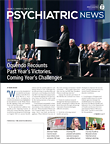The National Institute on Alcohol Abuse and Alcoholism (NIAAA) has released a five-year strategic plan that focuses on areas in which the institute hopes to advance the diagnosis, treatment, and prevention of alcohol-related problems.
The plan encompasses five broad goals for biomedical research: identifying the mechanisms underlying alcohol’s effects, improving diagnosis of alcohol disorders and their consequences, developing and improving prevention strategies, advancing treatment options, and increasing public awareness.
“Rather than just create a list of generic strategies within each goal, NIAAA focused on key areas where we are poised to make the most progress in the coming years,” said NIAAA Acting Deputy Director Patricia Powell, Ph.D.
Powell added that this new vision will not dramatically shift funding allocated to NIAAA’s various research portfolios. Rather, each specific portfolio will prioritize certain objectives.
For example, under the diagnosis goal, NIAAA is investing in three-dimensional image analysis to improve the diagnosis of fetal alcohol spectrum disorder (FASD). These scanners create heat maps of facial topography that can be quickly analyzed to determine whether an FASD is present. The institute also hopes to identify prenatal biomarkers, whether metabolic, genetic, or image based, to diagnose FASD in utero and allow for early intervention efforts.
Pharmacology is another important area. There are only three FDA-approved medications for alcohol use disorder (AUD), and each has some drawbacks. Powell said that recent early-stage clinical work in this area has shown some promise (for example, a vasopressin receptor antagonist, ABT-436, has had encouraging phase 2b clinical results), but agreed that many obstacles remain that slow the drug-development process and contribute to high failure rates of initially promising drugs.
As part of the strategic plan, NIAAA is seeking to improve both animal models of alcohol disorders and human laboratory paradigms. “We must appreciate that alcohol disorders are heterogenous and build clinical studies around specific aspects of the disorder,” she said. For example, if a medication being studied is targeted at anxiety pathways, the research needs to include participants with high anxiety levels and employ validated tests that assess anxiety-induced cravings.
Powell said that NIAAA will also continue to develop better technology for measuring alcohol exposure. Current tools for alcohol monitoring work well but can be cumbersome and do not offer true real-time monitoring. The institute recently held a monitoring-device competition that resulted in a prototype wristband that continuously measures alcohol levels via sweat readings. Such a device is useful for not only research purposes but also commercial applications so that, for example, individuals can unobtrusively monitor their level of intoxication, said Powell.
Perhaps one of the most significant items noted in the NIAAA strategic plan is the proposed development of a new diagnostic model of AUD, the Addictions Neuroclinical Assessment (ANA). The ANA is envisioned as a wide-ranging battery of tests, including genetic, neuroimaging, and behavioral assessments, that can identify clinical subtypes of AUD, which in turn can guide the development of personalized treatments.
In some ways, this initiative resembles the National Institute of Mental Health’s (NIMH) initiative to reclassify mental disorders by integrating clinical symptoms with neurobiological measures.
“Our approach is not as sweeping as NIMH’s, since we are only looking at one psychiatric disorder, but it goes back to the fact that AUD is heterogenous,” Powell said. “One person may drink too much because alcohol is wonderful and intoxicating, while another does so because that person can’t leave the house and face the world. Right now, both would be considered as having the same disease.”
Even though the approach may not be that sweeping, Powell said this is still a dramatic change, and NIAAA will pilot the adoption of ANA within the institute’s intramural research division. ■
The NIAAA Strategic Plan 2017-2021: Charting a Course for the Next Five Years of Alcohol Research can be accessed
here.
